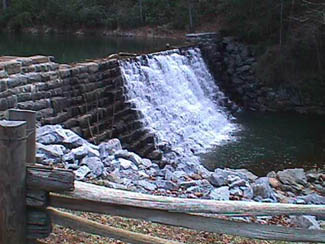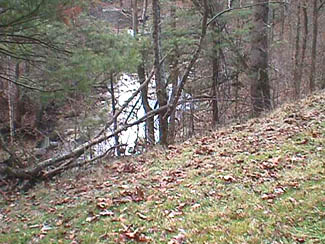A Winter Walk Enjoying a trail on the James River during the eve of the year
It's been said the beauty of winter isA winter walk is a delightful experience in our part of the country because it breaks the routine during a time of year when we tend to let ourselves become housebound. Winter air is invigorating, still, cool, and the trails are deserted. The views are open with no leaves to obscure. We drive to the Blue Ridge Parkway, 10 miles from our home in the foothills, and walk a path that traverses the hillsides parallel to the Parkway and Otter Creek. On the southern terminus of the trail is the James River Visitor's Center. The path begins near the building that houses nature exhibits and an on-duty ranger during warmer months. In many areas the James River is treacherous with rocks and rapids. Here, there are no obstructions but the current is fast and strong on the journey from West Virginia to Richmond and the Chesapeake Bay. Across the river is a restored lock of the Kanawha Canal, once thought to be the future link of East to West. Over 100 years ago, General Thomas J. Stonewall Jackson's body came to Lynchburg by train and was trans-shipped on a canal boat to Lexington, Va. for honors and burial. We gaze at the flat park-like area around the lock from our height across the James, and think of days past as a jetliner leaves its cottony contrail signature in the slate-blue sky. We're inexorably linked here in Virginia: the present to the past. The trail follows the meandering creek north; it's an easy walk and we can set a good pace to maximize the benefit of our exercise. At one point, a rock wall banks the path, over 20 feet high and built into the side of the hill. The men of the Civilian Conservation Corps constructed it more than 50 years ago. Many of the stones weigh hundreds of pounds. The Corps built much of the parkway and most of the other national park facilities in the area. The men were housed, often in tents, and fed sustaining but unimaginative meals. Reading and writing were required subjects for the illiterate. Other subjects were available for those with basic skills. All corps members were treated with dignity. For a few dollars a week, the men left their mark and were grateful for steady employment during the years of the Great Depression. The CCC enabled them to send home minimal paychecks, while many of their friends and relatives were without work. I never walk a trail, eat a meal in one of the picnic areas or stay in the campgrounds without thinking of the strong-backed and brave-hearted men of the CCC. Our walk is quiet, but not silent. We hear trains from the far side of the river, empty trains moving rapidly from East to West; and heavily loaded trains huffing East, filled with coal from the mines of West (and western) Virginia, bound for ships in Hampton Roads. The subdued whish sounds of tires on asphalt signal an occasional vehicle on the parkway. The creek gurgles and bubbles as it cascades over rocks worn smooth by centuries of passing water.
A great blue heron hears us and takes flight. She appears awkward with her spindly legs, great flapping wings and elongated head, but as she gains height and maneuverability, her silhouette is transformed into a model worthy of an artist's sculpture. Patches of leftover snow dot the ground, tucked among pockets of terrain where the sun hasn't melted winter's covering. One spot, high on the ridge, at a sharp bend in the trail where rocks are prevalent, boasts a mini-waterfall of ice. Our walks are a time apart. I empty my mind of all but the pleasure of my surroundings. For the hour or more that we trek the quiet path, I give no thought to life's problems. I refresh and renew, fortify myself to face again the time indoors. I know the respite of a winter walk is always only minutes away and mine whenever I need or want it.
Copyright © The Southerner 2000. 
|

